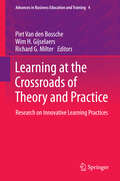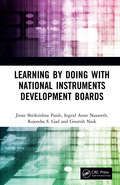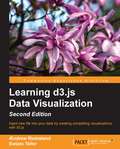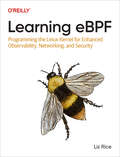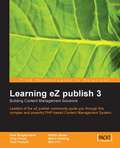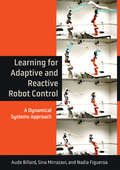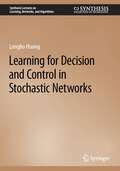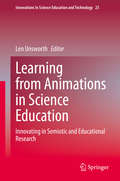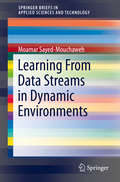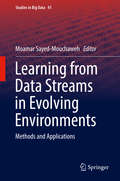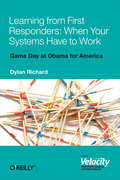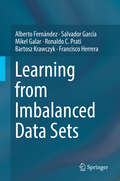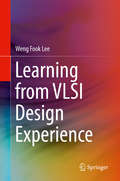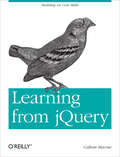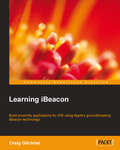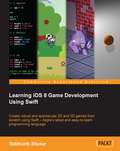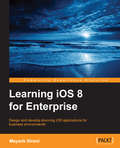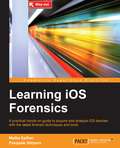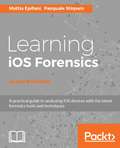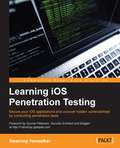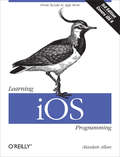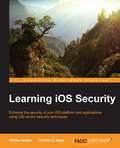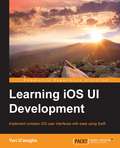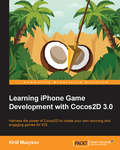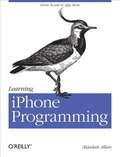- Table View
- List View
Learning at the Crossroads of Theory and Practice
by Wim H. Gijselaers Piet Van den Bossche Richard G. MilterCore concepts in education are changing. For example, professional performance or expertise is not uniquely the fruit of specialist knowledge acquired at professional schools, but the sum of influences exerted by a complex web of continuous learning opportunities for which an individual is well (or ill) prepared by their schools and their workplace. The key contributory factors to professional expertise are how professional schools connect to professional practice, how schools prepare graduates for continuous learning, and how the workplace endorses continuous development. Thus, the question this volume addresses--how to design learning and working environments that facilitate the integration of these three elements--is at the heart of contemporary pedagogical theory. The authors also ask a second vital question: how do we educate learners that go on to maximize their life's learning opportunities by regulating their own ongoing learning? Learning at the Crossroads of Theory and Practice argues that with the theory of learning at a crossroads, this is an unprecedented opportunity for learning about learning. The book sheds light on different elements of this challenge: integrating theory and practice in business education, generating and fully exploiting workplace learning opportunities, and enriching our classrooms by coupling theoretical knowledge with the richness of real-life experience.
Learning by Doing with National Instruments Development Boards
by Rajendra S. Gad Jivan Shrikrishna Parab Ingrid Anne Nazareth Gourish NaikLearning by Doing with National Instruments Development Boards starts with a brief introduction to LabVIEW programming, which is required to explore the National Instrument platform, an introduction that includes detailed installation and licensing setup. Further, it gives the features and configuration setup of NI SPEEDY-33, NI ELVIS and myRIO boards. The focus of the book is on worked-out case studies for students working in different areas of electronics such as basic digital design, biomedical instrumentation, sensors and measurement. Data acquisition using SPEEDY-33, NI –ELVIS and myRIO kits is also odiscussed. The book also examines the myRIO platform.
Learning d3.js Data Visualization - Second Edition
by Swizec Teller Ændrew RininslandInject new life into your data by creating compelling visualizations with d3.js About This Book * Understand how to best represent your data by developing the right kind of visualization * Harness the power of D3 by building interactive and real-time data-driven web visualizations * This book will provide a strong foundation in designing compelling web visualizations with D3.js Who This Book Is For This book is for web developers, data scientists, and anyone interested in representing data through interactive visualizations on the web with D3. Some basic JavaScript knowledge is expected, but no prior experience with data visualization or D3 is required to follow this book. What You Will Learn * Gain a solid understanding of the common D3 development idioms * Be able to input data, transform it, and output it as a visualization * Add simple effects and user interactions to a visualization * Find out how to write basic D3 code for server using Node.js * Automate testing visualizations using Mocha * Achieve fluency in ES2015, the most modern version of JavaScript In Detail D3 has emerged as one of the leading platforms to develop beautiful, interactive visualizations over the web. We begin by setting up a strong foundation, then build on this foundation book will take you through the entire world of reimagining data using interactive, animated visualizations created in D3.js. In addition to covering the various features of D3.js to build a wide range of visualizations, we also focus on the entire process of representing data through visualizations so that developers and those interested in data visualization will get the entire process right. We also include chapters that explore a wide range of visualizations through practical use cases. By the end of this book, you will have unlocked the mystery behind successful data visualizations and will be ready to use D3 to transform any data into a more engaging and sophisticated visualization. Style and approach This book has comprehensive explanation on how to leverage the power of D3.js to create powerful and creative visualizations through step by step instruction
Learning eBPF: Programming the Linux Kernel for Enhanced Observability, Networking, and Security
by Liz RiceWhat is eBPF? With this revolutionary technology, you can write custom code that dynamically changes the way the kernel behaves. It's an extraordinary platform for building a whole new generation of security, observability, and networking tools.This practical book is ideal for developers, system administrators, operators, and students who are curious about eBPF and want to know how it works. Author Liz Rice, chief open source officer with cloud native networking and security specialists Isovalent, also provides a foundation for those who want to explore writing eBPF programs themselves.With this book, you will:Learn why eBPF has become so important in the past couple of yearsWrite basic eBPF code, and manipulate eBPF programs and attach them to eventsExplore how eBPF components interact with Linux to dynamically change the operating system's behaviorLearn how tools based on eBPF can instrument applications without changes to the apps or their configurationDiscover how this technology enables new tools for observability, security, and networking
Learning eZ publish 3: Building content management solutions
by Ben PirtAlthough there is good quality reference documentation on eZ publish, there are currently no books available. Therefore, this book has been written from the ground up, in a tutorial/case study style to fill this gap. This book is for Web developers new to eZ publish, while experienced developers of eZ publish who want to consolidate their knowledge will learn new techniques from eZ publish masters. It has also been designed for those new to eZ publish while also being aimed at experienced developers who want to consolidate their knowledge and learn new tricks from eZ publish masters
Learning for Adaptive and Reactive Robot Control: A Dynamical Systems Approach (Intelligent Robotics and Autonomous Agents series)
by Aude Billard Sina Mirrazavi Nadia FigueroaMethods by which robots can learn control laws that enable real-time reactivity using dynamical systems; with applications and exercises.This book presents a wealth of machine learning techniques to make the control of robots more flexible and safe when interacting with humans. It introduces a set of control laws that enable reactivity using dynamical systems, a widely used method for solving motion-planning problems in robotics. These control approaches can replan in milliseconds to adapt to new environmental constraints and offer safe and compliant control of forces in contact. The techniques offer theoretical advantages, including convergence to a goal, non-penetration of obstacles, and passivity. The coverage of learning begins with low-level control parameters and progresses to higher-level competencies composed of combinations of skills. Learning for Adaptive and Reactive Robot Control is designed for graduate-level courses in robotics, with chapters that proceed from fundamentals to more advanced content. Techniques covered include learning from demonstration, optimization, and reinforcement learning, and using dynamical systems in learning control laws, trajectory planning, and methods for compliant and force control . Features for teaching in each chapter: • applications, which range from arm manipulators to whole-body control of humanoid robots; • pencil-and-paper and programming exercises; • lecture videos, slides, and MATLAB code examples available on the author&’s website . • an eTextbook platform website offering protected material[EPS2] for instructors including solutions.
Learning for Decision and Control in Stochastic Networks (Synthesis Lectures on Learning, Networks, and Algorithms)
by Longbo HuangThis book introduces the Learning-Augmented Network Optimization (LANO) paradigm, which interconnects network optimization with the emerging AI theory and algorithms and has been receiving a growing attention in network research. The authors present the topic based on a general stochastic network optimization model, and review several important theoretical tools that are widely adopted in network research, including convex optimization, the drift method, and mean-field analysis. The book then covers several popular learning-based methods, i.e., learning-augmented drift, multi-armed bandit and reinforcement learning, along with applications in networks where the techniques have been successfully applied. The authors also provide a discussion on potential future directions and challenges.
Learning from Animations in Science Education: Innovating in Semiotic and Educational Research (Innovations in Science Education and Technology #25)
by Len UnsworthThis book examines educational semiotics and the representation of knowledge in school science. It discusses the strategic integration of animation in science education. It explores how learning through the creation of science animations takes place, as well as how animation can be used in assessing student’s science learning. Science education animations are ubiquitous in a variety of different online sites, including perhaps the most popularly accessed YouTube site, and are also routinely included as digital augmentations to science textbooks. They are popular with students and teachers and are a prominent feature of contemporary science teaching. The proliferation of various kinds of science animations and the ready accessibility of sophisticated resources for creating them have emphasized the importance of research into various areas: the nature of the semiotic construction of knowledge in the animation design, the development of critical interpretation of available animations, the strategic selection and use of animations to optimize student learning, student creation of science animations, and using animation in assessing student science learning. This book brings together new developments in these research agendas to further multidisciplinary perspectives on research to enhance the design and pedagogic use of animation in school science education. Chapter 1 is available open access under a Creative Commons Attribution 4.0 International License via link.springer.com.
Learning from Data Streams in Dynamic Environments
by Moamar Sayed-MouchawehThis book addresses the problems of modeling, prediction, classification, data understanding and processing in non-stationary and unpredictable environments. It presents major and well-known methods and approaches for the design of systems able to learn and to fully adapt its structure and to adjust its parameters according to the changes in their environments. Also presents the problem of learning in non-stationary environments, its interests, its applications and challenges and studies the complementarities and the links between the different methods and techniques of learning in evolving and non-stationary environments.
Learning from Data Streams in Evolving Environments: Methods And Applications (Studies in Big Data #41)
by Moamar Sayed-MouchawehThis edited book covers recent advances of techniques, methods and tools treating the problem of learning from data streams generated by evolving non-stationary processes. The goal is to discuss and overview the advanced techniques, methods and tools that are dedicated to manage, exploit and interpret data streams in non-stationary environments. The book includes the required notions, definitions, and background to understand the problem of learning from data streams in non-stationary environments and synthesizes the state-of-the-art in the domain, discussing advanced aspects and concepts and presenting open problems and future challenges in this field. Provides multiple examples to facilitate the understanding data streams in non-stationary environments;Presents several application cases to show how the methods solve different real world problems;Discusses the links between methods to help stimulate new research and application directions.
Learning from First Responders: When Your Systems Have to Work
by Dylan RichardOne of the side stories of the 2012 presidential campaign was the success of Obama's software team. The team built their software in-house, and put into practice many ideas from the DevOps world. Game day was one of the most important: an exercise in which part of the team tried as hard as possible to break their systems, while the rest of the team tried to keep things running. They simulated everything from database failure to massive network outages. And as a result, when the election came, they were certain that they could respond to any crisis.
Learning from Imbalanced Data Sets
by Francisco Herrera Salvador García Mikel Galar Alberto Fernández Ronaldo C. Prati Bartosz KrawczykThis book provides a general and comprehensible overview of imbalanced learning. It contains a formal description of a problem, and focuses on its main features, and the most relevant proposed solutions. Additionally, it considers the different scenarios in Data Science for which the imbalanced classification can create a real challenge. This book stresses the gap with standard classification tasks by reviewing the case studies and ad-hoc performance metrics that are applied in this area. It also covers the different approaches that have been traditionally applied to address the binary skewed class distribution. Specifically, it reviews cost-sensitive learning, data-level preprocessing methods and algorithm-level solutions, taking also into account those ensemble-learning solutions that embed any of the former alternatives. Furthermore, it focuses on the extension of the problem for multi-class problems, where the former classical methods are no longer to be applied in a straightforward way.This book also focuses on the data intrinsic characteristics that are the main causes which, added to the uneven class distribution, truly hinders the performance of classification algorithms in this scenario. Then, some notes on data reduction are provided in order to understand the advantages related to the use of this type of approaches.Finally this book introduces some novel areas of study that are gathering a deeper attention on the imbalanced data issue. Specifically, it considers the classification of data streams, non-classical classification problems, and the scalability related to Big Data. Examples of software libraries and modules to address imbalanced classification are provided.This book is highly suitable for technical professionals, senior undergraduate and graduate students in the areas of data science, computer science and engineering. It will also be useful for scientists and researchers to gain insight on the current developments in this area of study, as well as future research directions.
Learning from VLSI Design Experience
by Weng Fook LeeThis book shares with readers practical design knowledge gained from the author’s 24 years of IC design experience. The author addresses issues and challenges faced commonly by IC designers, along with solutions and workarounds. Guidelines are described for tackling issues such as clock domain crossing, using lockup latch to cross clock domains during scan shift, implementation of scan chains across power domain, optimization methods to improve timing, how standard cell libraries can aid in synthesis optimization, BKM (best known method) for RTL coding, test compression, memory BIST, usage of signed Verilog for design requiring +ve and -ve calculations, state machine, code coverage and much more. Numerous figures and examples are provided to aid the reader in understanding the issues and their workarounds.
Learning from jQuery: Building on Core Skills
by Callum MacraeIf you’re comfortable with jQuery but a bit shaky with JavaScript, this concise guide will help you expand your knowledge of the language—especially the code that jQuery covers up for you. Many jQuery devotees write as little code as possible, but with some JavaScript under your belt, you can prevent errors, reduce overhead, and make your application code more efficient.This book explores event handling, prototypes, and working with the DOM and AJAX through examples and lots of code. You’ll learn common conventions and patterns in JavaScript and—if you’ve never coded with JavaScript before—a tutorial will take you through the basics.Enhance your jQuery code by using object constructors and prototypesReduce overhead and gain more control by handling events with JavaScriptWork with the DOM much faster with JavaScript than you can with jQuerySend a few AJAX requests without having to load the entire jQuery libraryUnderstand the importance of JavaScript code standards, comments, code reuse, and anti-patternsEnlist JavaScript resources, such as a good IDE, a syntax checker, and version control
Learning iBeacon
by Craig GilchristThis book is intended for iOS developers who are curious to learn about iBeacon and want to start building applications for iOS. You will gain everything you need to know to master indoor location functionality using Bluetooth beacon technology. No knowledge of iBeacon is assumed.
Learning iOS 8 Game Development Using Swift
by Siddharth ShekarThis book is for novices as well as proficient game developers who want to learn more about game development using Swift. If you are from a 2D game development background and would like to learn the basics of 3D game development, this book is for you. Additionally, if you want to learn the basics of graphics programming and shaders, this book will be a good starting point.
Learning iOS 8 for Enterprise
by Mayank BiraniIf you are an experienced iPhone application developer or even a newbie, this book will help you to build on and explore your technical skills. This book is very helpful for those who want to learn about the new framework of iOS 7 and iOS 8.
Learning iOS Forensics
by Pasquale Stirparo Mattia EpifaniIf you are a digital forensics examiner daily involved in the acquisition and analysis of mobile devices and want to have a complete overview of how to perform your work on iOS devices, this book is definitely for you.
Learning iOS Forensics - Second Edition
by Pasquale Stirparo Mattia EpifaniA practical guide to analyzing iOS devices with the latest forensics tools and techniques About This Book * This book is a comprehensive update to Learning iOS Forensics * This practical book will not only cover the critical aspects of digital forensics, but also mobile forensics * Whether you're a forensic analyst or an iOS developer, there's something in this book for you * The authors, Mattia Epifani and Pasquale Stirparo, are respected members of the community, they go into extensive detail to cover critical topics Who This Book Is For The book is for digital forensics analysts, incident response analysts, IT security experts, and malware analysts. It would be beneficial if you have basic knowledge of forensics What You Will Learn * Identify an iOS device between various models (iPhone, iPad, iPod Touch) and verify the iOS version installed * Crack or bypass the protection passcode chosen by the user * Acquire, at the most detailed level, the content of an iOS Device (physical, advanced logical, or logical) * Recover information from a local backup and eventually crack the backup password * Download back-up information stored on iCloud * Analyze system, user, and third-party information from a device, a backup, or iCloud * Examine malicious apps to identify data and credential thefts In Detail Mobile forensics is used within many different domains, but is chiefly employed in the field of information security. By understanding common attack vectors and vulnerability points, security professionals can develop measures and examine system architectures to harden security on iOS devices. This book is a complete manual on the identification, acquisition, and analysis of iOS devices, updated to iOS 8 and 9. You will learn by doing, with various case studies. The book covers different devices, operating system, and apps. There is a completely renewed section on third-party apps with a detailed analysis of the most interesting artifacts. By investigating compromised devices, you can work out the identity of the attacker, as well as what was taken, when, why, where, and how the attack was conducted. Also you will learn in detail about data security and application security that can assist forensics investigators and application developers. It will take hands-on approach to solve complex problems of digital forensics as well as mobile forensics. Style and approach This book provides a step-by-step approach that will guide you through one topic at a time. This intuitive guide focuses on one key topic at a time. Building upon the acquired knowledge in each chapter, we will connect the fundamental theory and practical tips by illustrative visualizations and hands-on code examples.
Learning iOS Penetration Testing
by Swaroop YermalkarSecure your iOS applications and uncover hidden vulnerabilities by conducting penetration testsAbout This BookAchieve your goal to secure iOS devices and applications with the help of this fast paced manualFind vulnerabilities in your iOS applications and fix them with the help of this example-driven guideAcquire the key skills that will easily help you to perform iOS exploitation and forensics with greater confidence and a stronger understandingWho This Book Is ForThis book is for IT security professionals who want to conduct security testing of applications. This book will give you exposure to diverse tools to perform penetration testing. This book will also appeal to iOS developers who would like to secure their applications, as well as security professionals. It is easy to follow for anyone without experience of iOS pentesting.What You Will LearnUnderstand the basics of iOS app development, deployment, security architecture, application signing, application sandboxing, and OWASP TOP 10 for mobileSet up your lab for iOS app pentesting and identify sensitive information stored locallyPerform traffic analysis of iOS devices and catch sensitive data being leaked by side channelsModify an application's behavior using runtime analysisAnalyze an application's binary for security protectionAcquire the knowledge required for exploiting iOS devicesLearn the basics of iOS forensicsIn DetailiOS has become one of the most popular mobile operating systems with more than 1.4 million apps available in the iOS App Store. Some security weaknesses in any of these applications or on the system could mean that an attacker can get access to the device and retrieve sensitive information. This book will show you how to conduct a wide range of penetration tests on iOS devices to uncover vulnerabilities and strengthen the system from attacks.Learning iOS Penetration Testing discusses the common vulnerabilities and security-related shortcomings in an iOS application and operating system, and will teach you to conduct static and dynamic analysis of iOS applications.This practical guide will help you uncover vulnerabilities in iOS phones and applications. We begin with basics of iOS security and dig deep to learn about traffic analysis, code analysis, and various other techniques. Later, we discuss the various utilities, and the process of reversing and auditing.Style and approachThis fast-paced and practical guide takes a step-by-step approach to penetration testing with the goal of helping you secure your iOS devices and apps quickly.
Learning iOS Programming: From Xcode to App Store
by Alasdair AllanGet a rapid introduction to iPhone, iPad, and iPod touch programming. With this easy-to-follow guide, you’ll learn how to develop your first marketable iOS application, from opening Xcode to submitting your product to the App Store. Whether you’re a developer new to Mac programming or an experienced Mac developer ready to tackle iOS, this is your book.You’ll learn about Objective-C and the core frameworks hands-on by writing several sample iOS applications, giving you the basic skills for building your own applications independently. Packed with code samples, this book is refreshed and updated for iOS 6 and Xcode 4.Discover the advantages of building native iOS appsGet started with Objective-C and the Cocoa Touch frameworksDive deep into the table view classes for building user interfacesHandle data input, parse XML and JSON documents, and store data on SQLiteUse iOS sensors, including the accelerometer, magnetometer, camera, and GPSBuild apps that use the Core Location and MapKit frameworksIntegrate Apple’s iCloud service into your applicationsWalk through the process of distributing your polished app to the App Store
Learning iOS Security
by Allister Banks Charles S. EdgeThis book is intended for mobile security professionals who want to learn how to secure iOS operating systems and its applications. Any knowledge of iOS architecture would be an added advantage.
Learning iOS UI Development
by Yari D'AregliaImplement complex iOS user interfaces with ease using Swift About This Book * Build compelling user interfaces that users will enjoy using the iOS UIKit framework * Make your iOS apps easily recognizable and familiar with the UIKit framework * Use this comprehensive, step-by-step guide to create a complete custom layout Who This Book Is For This easy-to-follow guide is perfect for beginner-level iOS developers who want to become proficient in user interface development. It would also be useful for experienced iOS developers who need a complete overview of this broad topic all in one place, without having to consult various sources. What You Will Learn * Understand the basic requirements to work with iOS user interfaces * Get to know about the UI tools, frameworks, and built-in components * Plot dynamic layout structures using Auto Layout * Shape and implement adaptive user interfaces for different screen sizes * Draw and animate your user interfaces using the CALayer and UIKit animations * Intercept and handle user touches to create user interface interactivity * Create and depict totally custom controls * Design with iOS through Core Graphics In Detail Through this comprehensive one-stop guide, you'll get to grips with the entire UIKit framework and in a flash, you'll be creating modern user interfaces for your iOS devices using Swift. Starting with an overview of the iOS drawing system and the available tools, you will then learn how to use these technologies to create adaptable layouts and custom elements for your applications. Next, you'll be introduced to other topics such as animation and code-drawing with Core Graphics, which will give you all the knowledge you need to create astonishing user interfaces. By the end of this book, you will have a solid foundation in iOS user interface development and will have gained valuable insights on the process of building firm and complex UIs. Style and approach This concise yet information-packed guide is full of step-by-step instructions and screenshots of real-life examples, delivered in a direct manner, to get you creating modern user interfaces for your iOS devices using SWIFT in no time.
Learning iPhone Game Development with Cocos2D 3.0
by Kirill MuzykovThis book is an easy-to-follow, step-by-step beginner's guide covering the full process of creating a game. It is packed with examples and illustrations, with comprehensive coverage of each topic. If you want to learn how to make games using the Cocos2D framework, this book is for you. If you would like to build a good foundation for a career in game development as an independent game developer or at a game studio, or if you just want to make games as a hobby, then you'll love this book. You should have some basic programming experience with Objective-C and Xcode. To run the code in this book, you will also need an Intel-based Macintosh running OS X Mountain Lion (or later).
Learning iPhone Programming
by Alasdair AllanGet the hands-on experience you need to program for the iPhone and iPod Touch. With this easy-to-follow guide, you'll build several sample applications by learning how to use Xcode tools, the Objective-C programming language, and the core frameworks. Before you know it, you'll not only have the skills to develop your own apps, you'll know how to sail through the process of submitting apps to the iTunes App Store. Whether you're a developer new to Mac programming or an experienced Mac developer ready to tackle the iPhone and iPod Touch, Learning iPhone Programming will give you a head start on building market-ready iPhone apps. Start using Xcode right away, and learn how to work with Interface Builder Take advantage of model-view-controller (MVC) architecture with Objective-C Build a data-entry interface, and learn how to parse and store the data you receive Solve typical problems while building a variety of challenging sample apps Understand the demands and details of App Store and ad hoc distribution Use iPhone's accelerometer, proximity sensor, GPS, digital compass, and camera Integrate your app with iPhone's preference pane, media playback, and more
